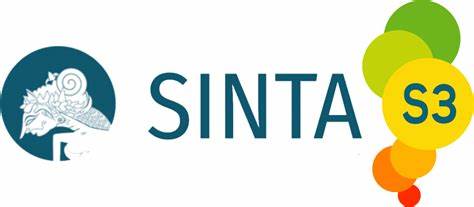INDONESIAN UNIVERSITY STUDENTS’ AND LECTURERS’ PERCEPTIONS OF ENGLISH MEDIUM INSTRUCTION
Keywords:
EMI, Higher education, Lecturer, PerceptionAbstract
English Medium Instruction is teaching in English, where the country's first language is not English. The internationalization of education and educational competence that makes campuses compete in their teaching and learning process, one of which is in the language of instruction. The purpose of this research is to investigate the perceptions of students and lecturers in higher education on medium instruction. This study used descriptive qualitative methods approach with an emphasis on qualitative data, with 60 students and 3 lecturers as respondents in this study. Questionnaires and interviews were used as tools to collect data from the respondents. The results of this study show that students and Lecturers had positive perception towards the use of English Medium Instruction. Students agreed that the use of English as a teaching medium can train their skills in English. The use of English in today's world of work means that everyone must learn English. Likewise with lecturers who make them challenged by teaching in English. The thing that is often faced by students and teachers in the process of learning to catch up with them is the lack of and understanding of vocabulary.
References
Artini, L. P. (2013). Penggunaan English As Medium of Instructions (Emi) Dan Konsekuensinya Terhadap Proses Pembelajaran Ditinjau Dari Persepsi Siswa. Jurnal Ilmu Sosial Dan Humaniora, 2(1), 166–178. https://doi.org/10.23887/jish-undiksha.v2i1.1312
Barrios, E., Lopez-Gutierrez, A., & Lopez Agudo, L.-A. (2022). Language-related perceptions: How do they predict student satisfaction with a partial English Medium Instruction in Higher Education? Journal of English for Academic Purposes, 157–162.
Block, D., & Moncada-Comas, B. (2022). English-medium instruction in higher education and the ELT gaze: STEM lecturers’ self-positioning as NOT English language teachers. International Journal of Bilingual Education and Bilingualism, 25(2), 401–417. https://doi.org/10.1080/13670050.2019.1689917
Bolton, K., Hill, C., Bacon-Shone, J., & Peyronnin, K. (2022). EMI (English-medium instruction) in Indonesian higher education. World Englishes, 1–23. https://doi.org/10.1111/weng.12622
Chapple, J. (2015). Teaching in english is not necessarily the teaching of english. International Education Studies, 8(3), 1–13. https://doi.org/10.5539/ies.v8n3p1
Dearden, J. (2014). English as a medium of instruction – a growing global phenomenon. British Council, 1–34.
Dewi, A. (2017). English as a Medium of Instruction in Indonesian Higher Education: A Study of Lecturers’ Perceptions. Multilingual Education, 21, 241–258. https://doi.org/10.1007/978-3-319-51976-0_13
Duarte, J., & van der Ploeg, M. (2019). Plurilingual lecturers in English medium instruction in the Netherlands: the key to plurilingual approaches in higher education? European Journal of Higher Education, 9(3), 268–284. https://doi.org/10.1080/21568235.2019.1602476
Ekoç, A. (2020). English Medium Instruction (EMI) from the perspectives of students at a technical university in Turkey. Journal of Further and Higher Education, 44(2), 231–243. https://doi.org/10.1080/0309877X.2018.1527025
Farrell, T. S. C. (2020). Professional development through reflective practice for English-medium instruction (EMI) teachers. International Journal of Bilingual Education and Bilingualism, 23(3), 277–286. https://doi.org/10.1080/13670050.2019.1612840
Fithriani, R. (2021). Code- Switching As an Efl Instructional Strategy: an Insight To Indonesian Lecturers’ Practices. Language Literacy: Journal of Linguistics, Literature, and Language Teaching, 5(1), 23–35. https://doi.org/10.30743/ll.v5i1.3622
Galloway, N., Numajiri, T., & Rees, N. (2020). The ‘ internationalisation ’ , or ‘ Englishisation ’ , of higher education in East Asia. 395–414.
He, J. J., & Chiang, S. Y. (2016). Challenges to English-medium instruction (EMI) for international students in China: A learners’ perspective. English Today, 32(4), 63–67. https://doi.org/10.1017/S0266078416000390
Hou, A. Y. C., Morse, R., Chiang, C. L., & Chen, H. J. (2013). Challenges to quality of English medium instruction degree programs in Taiwanese universities and the role of local accreditors: A perspective of non-English-speaking Asian country. Asia Pacific Education Review, 14(3), 359–370. https://doi.org/10.1007/s12564-013-9267-8
Jiang, A. L., & Zhang, L. J. (2019). Chinese students’ perceptions of English learning affordances and their agency in an English-medium instruction classroom context. Language and Education, 33(4), 322–339. https://doi.org/10.1080/09500782.2019.1578789
Jiang, L., Zhang, L. J., & May, S. (2019). Implementing English-medium instruction (EMI) in China: teachers’ practices and perceptions, and students’ learning motivation and needs*. International Journal of Bilingual Education and Bilingualism, 22(2), 107–119. https://doi.org/10.1080/13670050.2016.1231166
Karim, A., Kabilan, M. K., Ahmed, Z., Reshmin, L., & Rahman, M. M. (2021). The Medium of Instruction in Bangladeshi Higher Education Institutions: Bangla, English, or Both? Journal of Language, Identity and Education, 00(00), 1–15. https://doi.org/10.1080/15348458.2020.1871353
Kim, E. G., Kweon, S. O., & Kim, J. (2017). Korean engineering students’ perceptions of English-medium instruction (EMI) and L1 use in EMI classes. Journal of Multilingual and Multicultural Development, 38(2), 130–145. https://doi.org/10.1080/01434632.2016.1177061
Kim, J., Choi, J., & Tatar, B. (2017). English-Medium Instruction and Intercultural Sensitivity: A Korean Case Study. Journal of Studies in International Education, 21(5), 467–482. https://doi.org/10.1177/1028315317720767
Kirkgöz, Y. (2009). Students’ and lecturers’ perceptions of the effectiveness of foreign language instruction in an English-medium university in Turkey. Teaching in Higher Education, 14(1), 81–93. https://doi.org/10.1080/13562510802602640
Kremer, M. M. (2020). Adopting English As a Medium of Instruction ( Emi ) in Brazil and Flanders ( Belgium ): Florianópolis, 73(1), 217–246. https://doi.org/DOI: http://dx.doi.org/10.5007/2175-8026.2020v73n1p217
Li, L. (2020). Student perceptions of the teaching of principles of management using English-medium instruction. Journal of Education for Business, 95(2), 115–120. https://doi.org/10.1080/08832323.2019.1604484
Lin, T., & Lei, J. (2021). English-Medium Instruction and Content Learning in Higher Education: Effects of Medium of Instruction, English Proficiency, and Academic Ability. SAGE Open, 11(4). https://doi.org/10.1177/21582440211061533
Lourenço, M., & Pinto, S. (2019). Expatriate and home teachers’ beliefs about English-medium instruction at a Portuguese university. European Journal of Higher Education, 9(3), 252–267. https://doi.org/10.1080/21568235.2019.1597750
Macaro, E., Curle, S., Pun, J., An, J., & Dearden, J. (2018). A systematic review of English medium instruction in higher education. Language Teaching, 51(1), 36–76. https://doi.org/10.1017/S0261444817000350
Pun, J. K. H., & Thomas, N. (2020). English medium instruction: Teachers’ challenges and coping strategies. ELT Journal, 74(3), 247–257. https://doi.org/10.1093/elt/ccaa024
Qiu, X., & Fang, C. (2022). Creating an effective English-Medium Instruction (EMI) classroom: Chinese undergraduate students’ perceptions of native and non-native English-speaking content teachers and their experiences. International Journal of Bilingual Education and Bilingualism, 25(2), 641–655. https://doi.org/10.1080/13670050.2019.1707769
Rahmadani, D. (2016). Students’ perception of English as a medium of instruction (EMI) in English classroom. Journal on English as a Foreign Language, 6(2), 131. https://doi.org/10.23971/jefl.v6i2.432
Santoso, W., & Rindu Kinasih, P. (2022). Understanding University Teachers’ Perspectives of English Medium Instruction in Indonesia. Elsya : Journal of English Language Studies, 4(3), 197–213. https://doi.org/10.31849/elsya.v4i3.11031
Setoningsih, D. A. (2022). Secondary Education Students’ and Teachers’ Perspectives on EMI. English Learning Innovation, 3(1), 17–26. https://doi.org/10.22219/englie.v3i1.19793
Siegel, J. (2020). English Medium Instruction ( EMI ) Lectures . The TESOL Encyclopedia of English Language Teaching, 1–6. https://doi.org/10.1002/9781118784235.eelt0992
Simbolon, N. E. (2021). English Medium Instruction (EMI) practice: Higher education internationalization in Indonesia. Englisia: Journal of Language, Education, and Humanities, 8(2), 72. https://doi.org/10.22373/ej.v8i2.8961
Simbolon, N. E. (2023). English Medium Instruction (EMI) in Higher Education: Insights from Indonesian Vocational Lecturers. Utamax : Journal of Ultimate Research and Trends in Education, 5(1), 12–21. https://doi.org/10.31849/utamax.v5i1.9973
Simbolon, N. E., Oliver, R., & Mercieca, P. (2020). Lecturers’ perceptions of english medium instruction (EMI) practice at a university in Indonesia. Pertanika Journal of Social Sciences and Humanities, 28(2), 1065–1081.
Tange, H. (2014). English-medium instruction at universities: global challenges. International Journal of Bilingual Education and Bilingualism, 37–41. https://doi.org/10.1080/13670050.2013.794604
Wayan, N., & Despitasari, P. (2021). Students’ perception of English medium of instruction (EMI) in Indonesia: A case study in a Business Communication course in a private higher education institution (HEI). Journal of Arts and Humanities, 10(04), 28–38.
Xie, W., & Curle, S. (2022). Success in English Medium Instruction in China: significant indicators and implications. International Journal of Bilingual Education and Bilingualism, 25(2), 585–597. https://doi.org/10.1080/13670050.2019.1703898
Downloads
Published
Issue
Section
License

This work is licensed under a Creative Commons Attribution-ShareAlike 4.0 International License.
The author is responsible for acquiring the permission(s) to reproduce any copyrighted figures, tables, data, or text that are being used in the submitted paper. Authors should note that text quotations of more than 250 words from a published or copyrighted work will require grant of permission from the original publisher to reprint. The written permission letter(s) must be submitted together with the manuscript.




